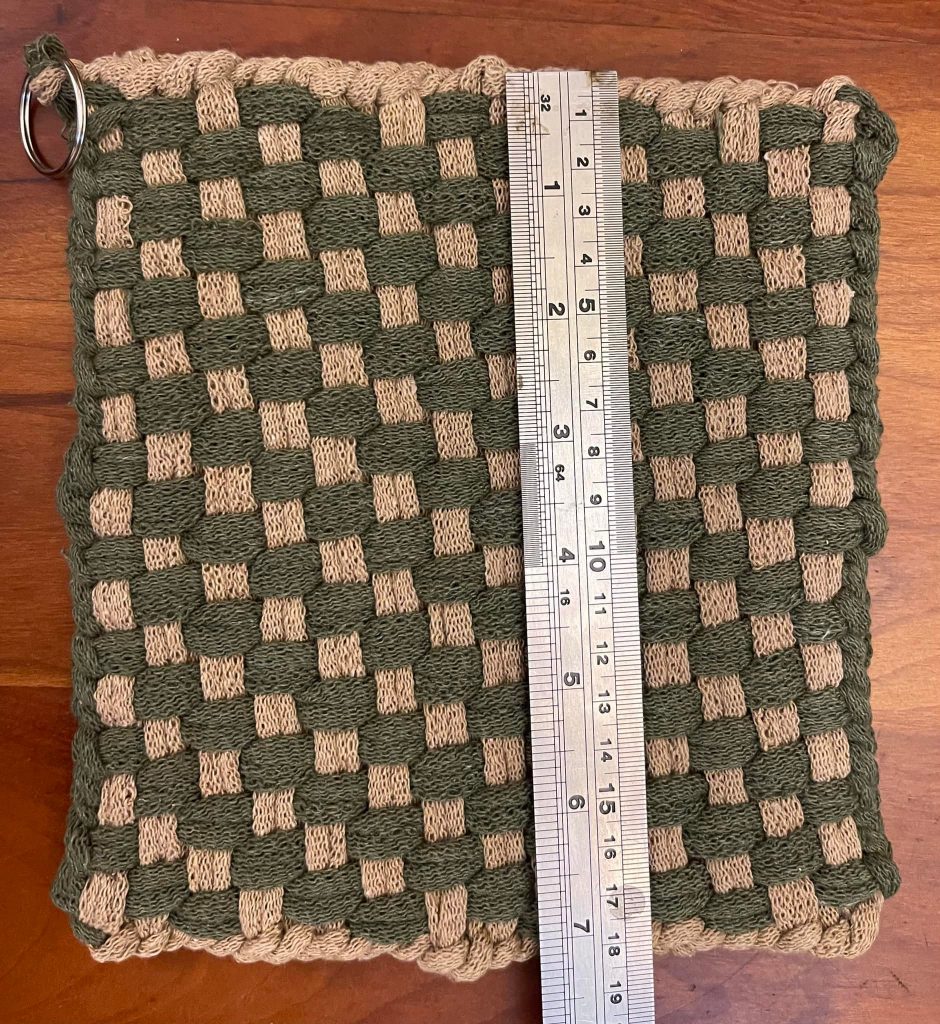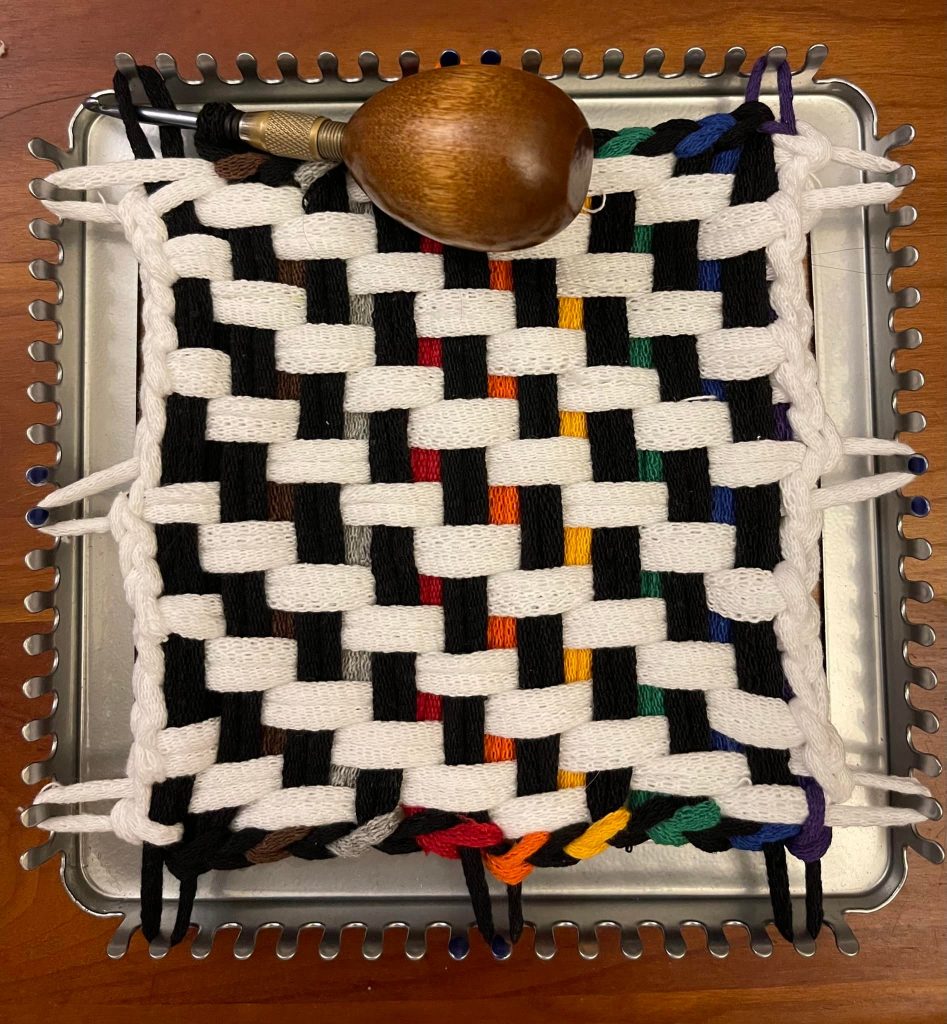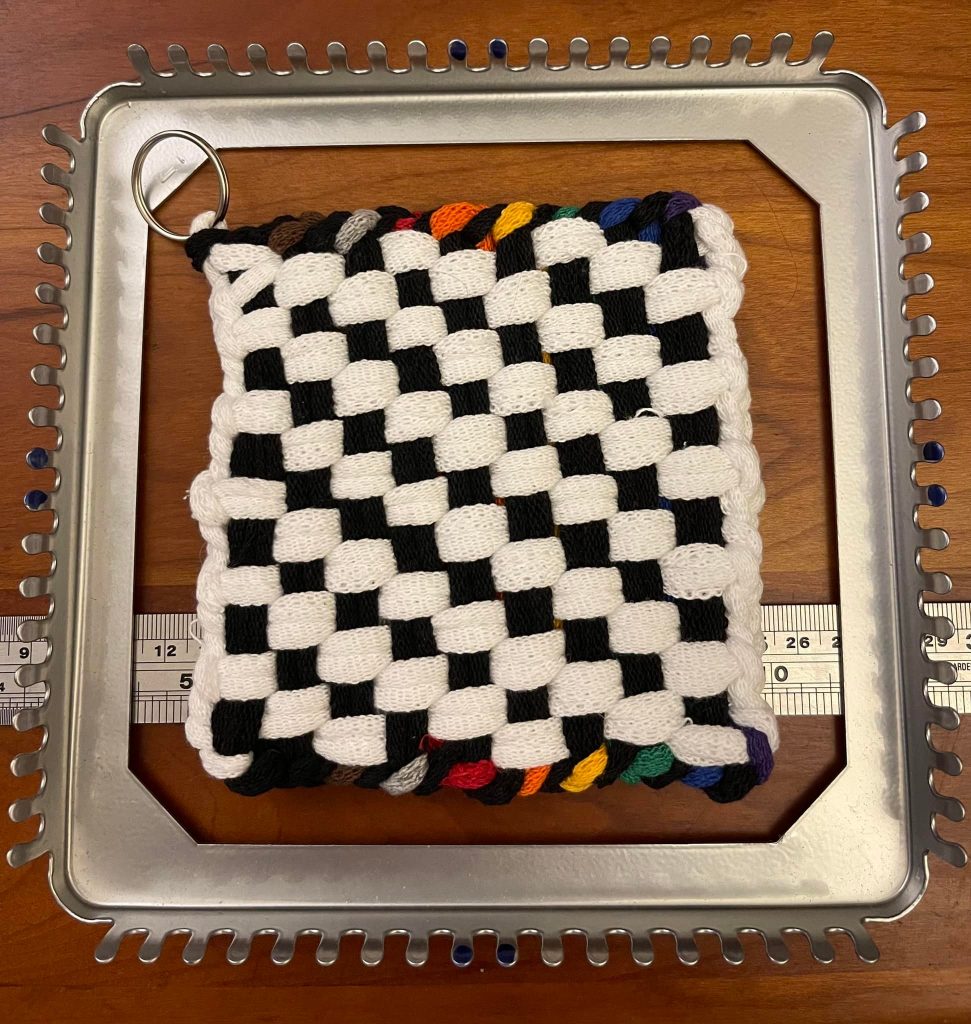This design integrates sections of two-one twill with contrasting one-two twill to produce a block effect.
The asymmetric pull of the twills adds a bit of a curve to the loops.
Woven by Piglet in the autumn of 2022.



A priceless portfolio of weaving charts for loop potholders.
This design integrates sections of two-one twill with contrasting one-two twill to produce a block effect.
The asymmetric pull of the twills adds a bit of a curve to the loops.
Woven by Piglet in the autumn of 2022.



A pleasant combination of the split-loop technique (which tends to produce tighter, flatter results) with two-two twill (which tends to have the opposite effect), this potholder winds up with dimensions similar to a plain-weave example, with with a lovely angled stripe.
Woven by Piglet in the autumn of 2022.
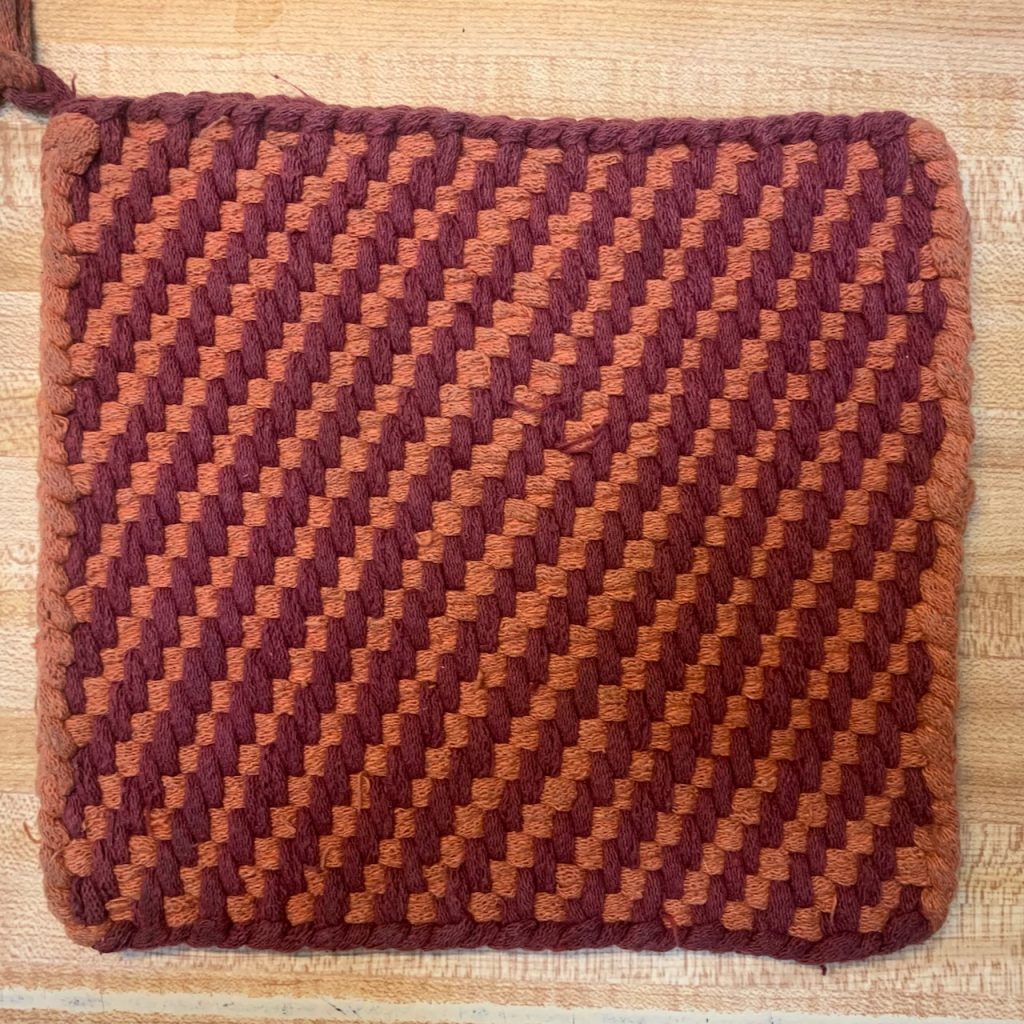
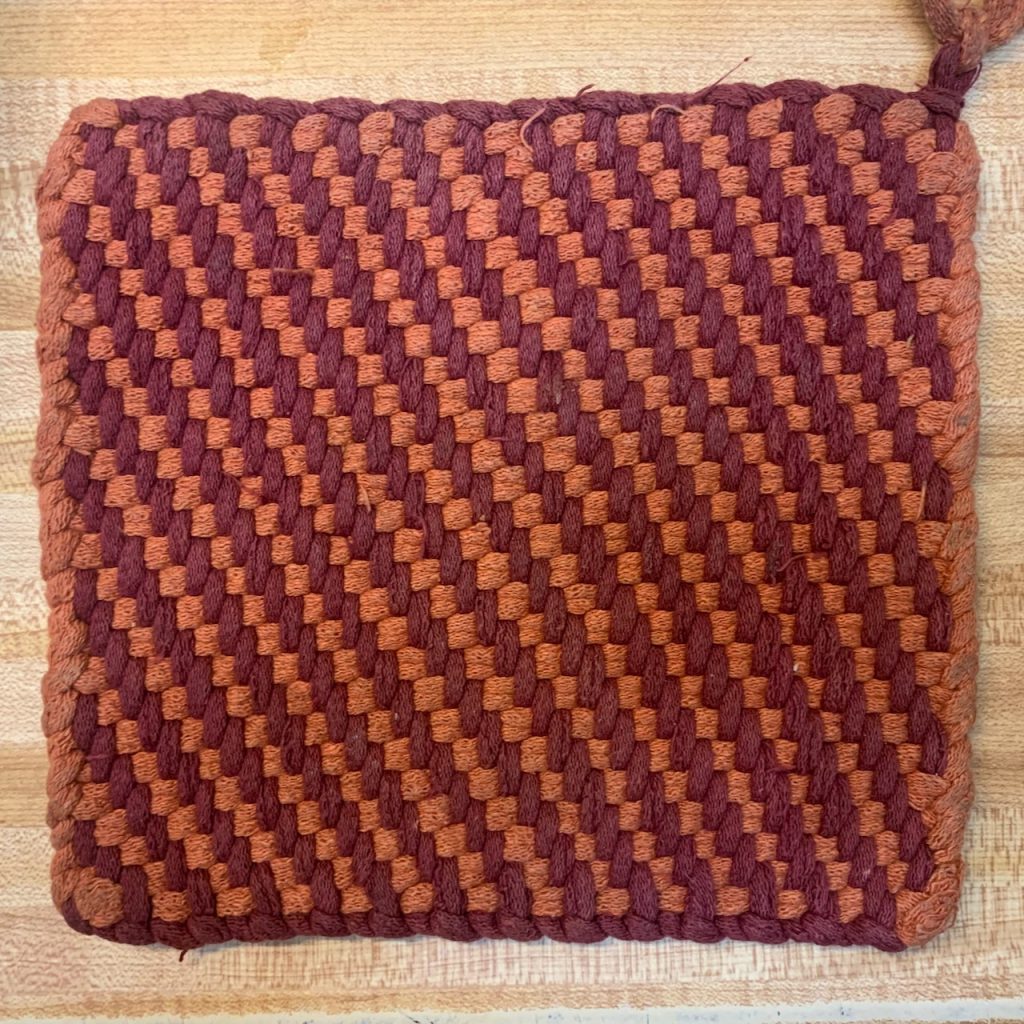
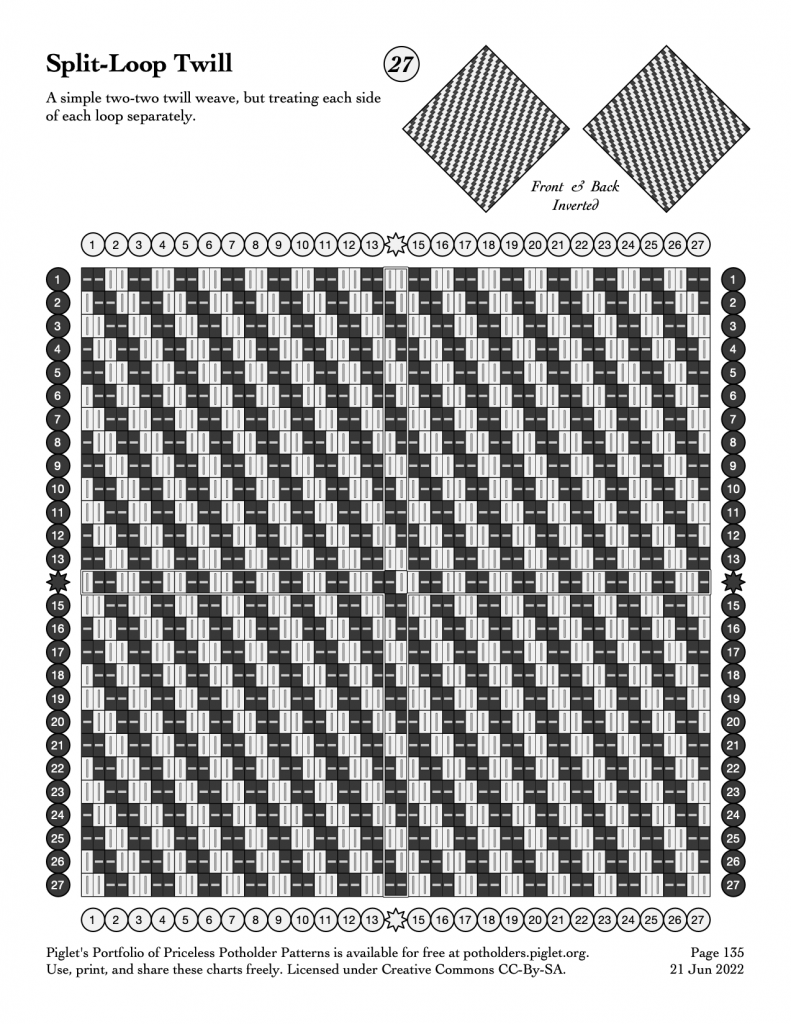
Inspired by a 2,700 year old (late Iron Age) textile fragment from a salt mine in Hallstatt, Austria, we have a lovely 2/2 twill with 3 direction changes, generating a regular fabric with 3-floats spread among the columns. The outcome is flexible and drapey, with very little bias, so it does not skew. In honor of the Iron Age culture, I chose flax for the background, and willow (which could be produced by woad overdyed with weld.)
I happened to have 7 loops in an older dye lot of willow. This is a perfect place to use them. The stripes are separated enough that the contrast is not obvious. The pattern change seems deliberate. They will fade in use to be closer in color. And the variation honors natural dying (as you might expect, overdying woad with weld can produce *many* shades).
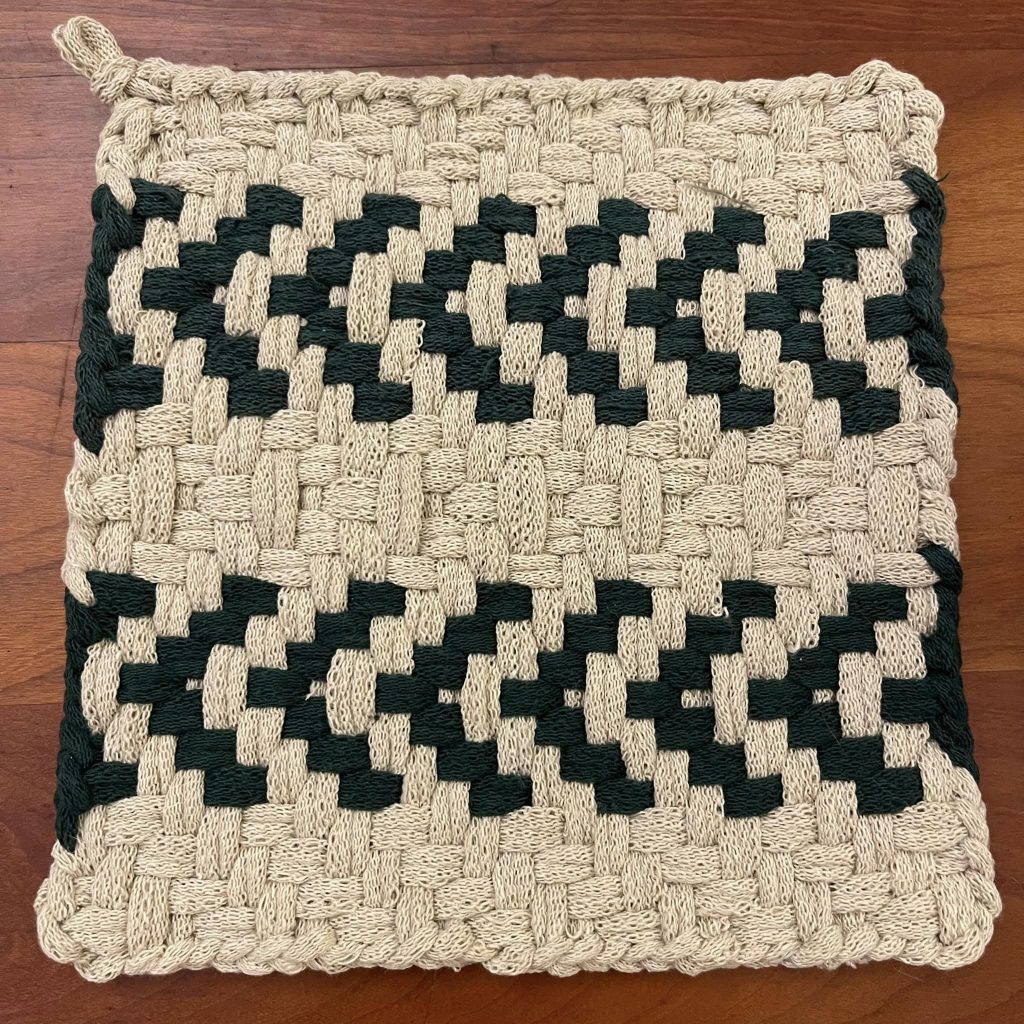


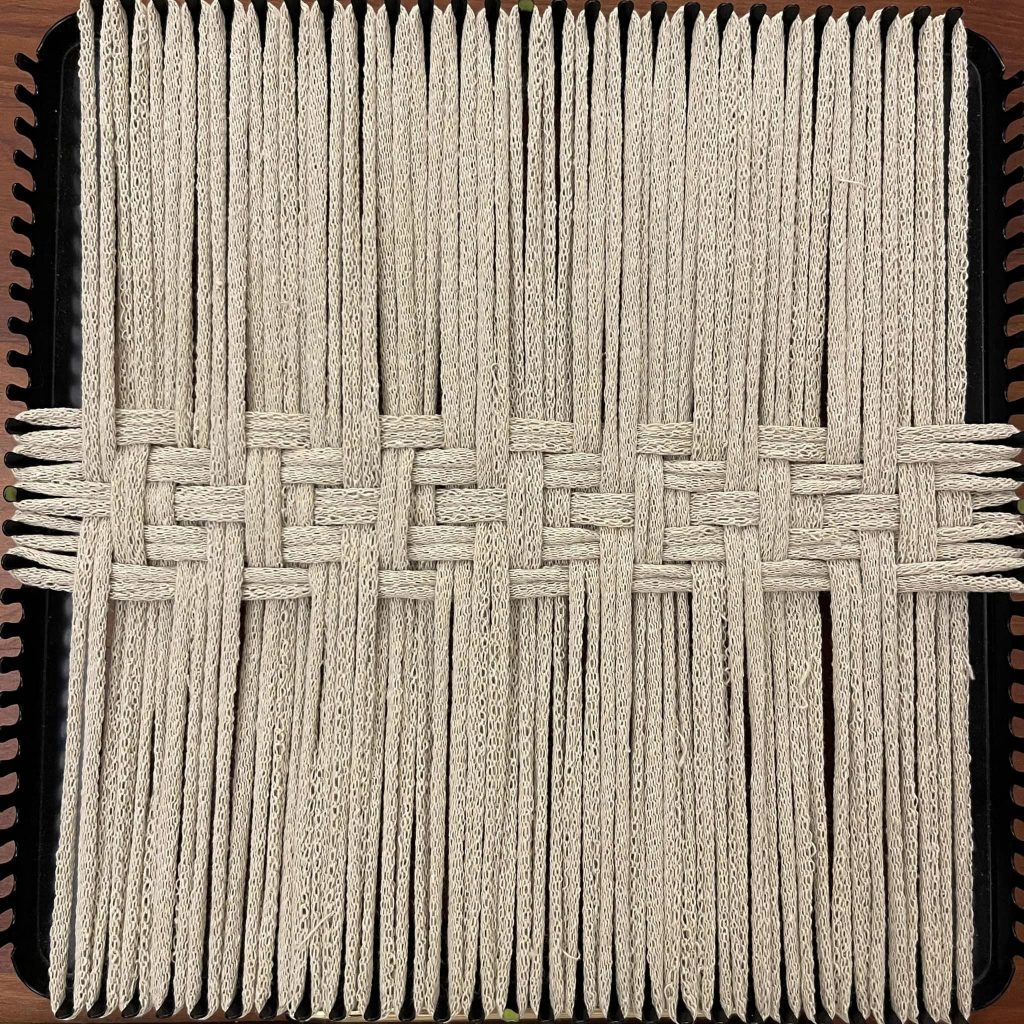

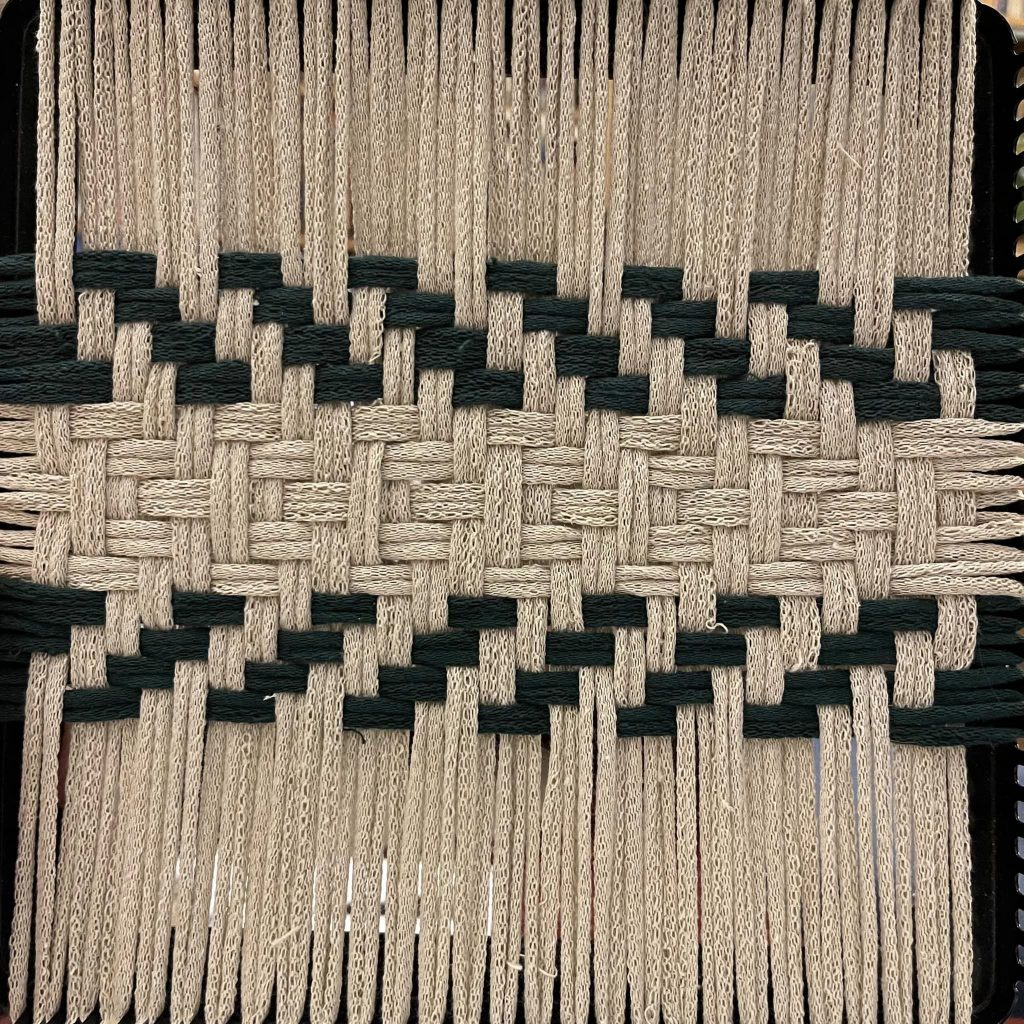
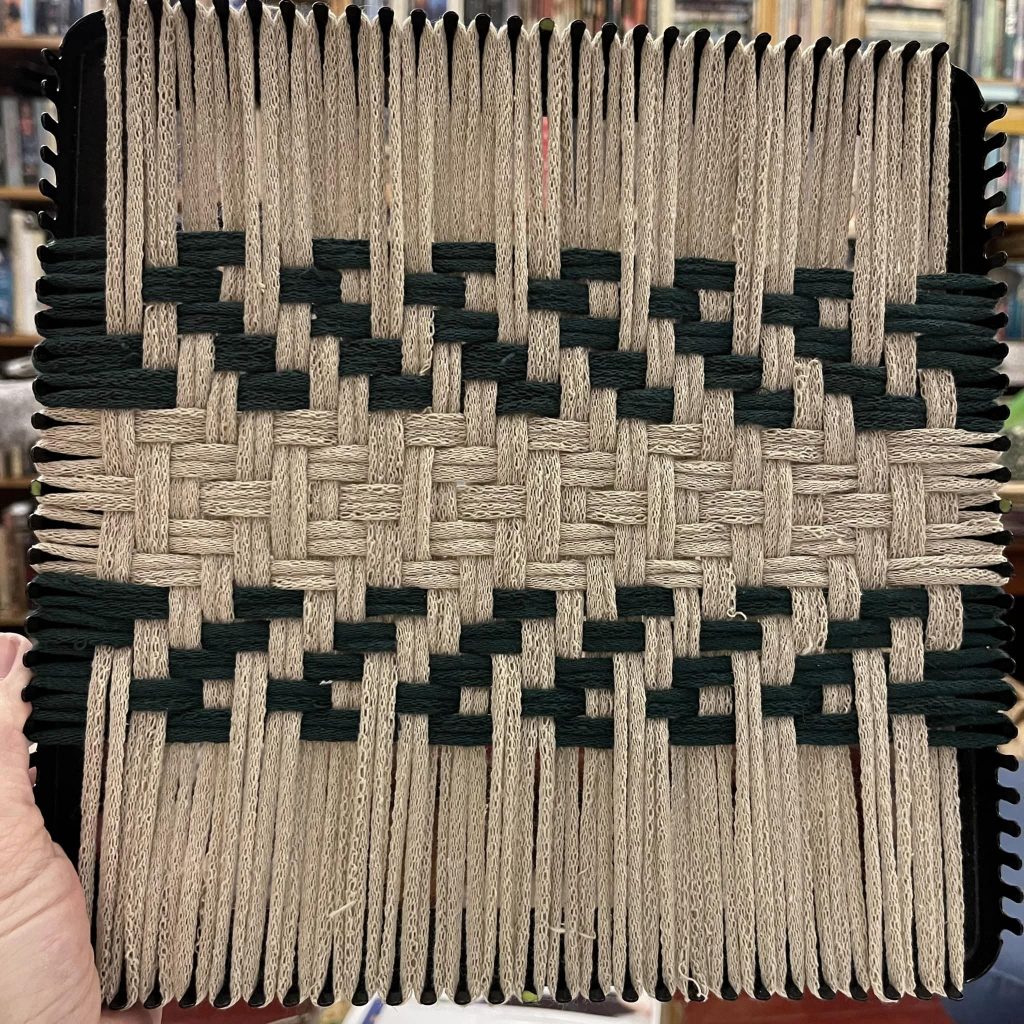

Here is the chart for this iteration. It is doable in a traditional version, with some design modification. I would not recommend plucking a subset of rows and columns directly from this 27-peg chart.
Last week we posted about “Three-Three Offset Twill,” a weaving pattern that produced a thick and textured fabric with prominent diagonal grooves. Here’s a variation with that same texture, but reversing the direction of the grooves part way across the fabric: “Three-Three Offset Bands.”
The photos below don’t really do the three-dimensionality of it full justice. The potholder is noticably thicker than a plain-weave potholder would be, and because the horizontal weft loops puff out over the surface of the vertical warp loops, both faces of the potholder winds up showing much more of that color, with more of the warp loops hidden inside the thickness of the fabric.
Here’s another intersting weave that produces a highly-textured extra-thick fabric: “Three-Three Offset Twill.” (It’s so hard to come up with good names!)
Each row is woven over three/under three, but instead of each row shifting over by one pick as you would for regular three-three twill, here you alternate between shifting over two and then over three.
When taken off the loom, the fabric tightens in and puffs up as with three-three twill, but the alternating shift sequence creates extra-wide wales with distinct grooves between them.
The back side features the same design, with the grooves reversed to line up under the ridges of the front. The weft floats spread out on each face, leaving the warp mostly hidden.
I’m not sure the photos below fully capture the texture, but in person it’s quite dramatic, and the feeling in your hand is very different than a plain weave.
Piglet has woven some fun color variations of this fabric, but to start with here’s a simple two-color example, with a white warp and colored weft.
Combining the techniques used in “Noughts and Crosses,” “Two-One Twill Pinstripes,” and “Tri-Color Two-One Corners,” this design features thin lines forming boxes on one side and crosswise corners on the other.
Woven in two-one twill, with over-three floats at the corners, this pattern weaves up quickly and shrinks when taken off the loom to form a dense fabric.
A 27-peg chart is also available, and tri-color versions are expected to follow.
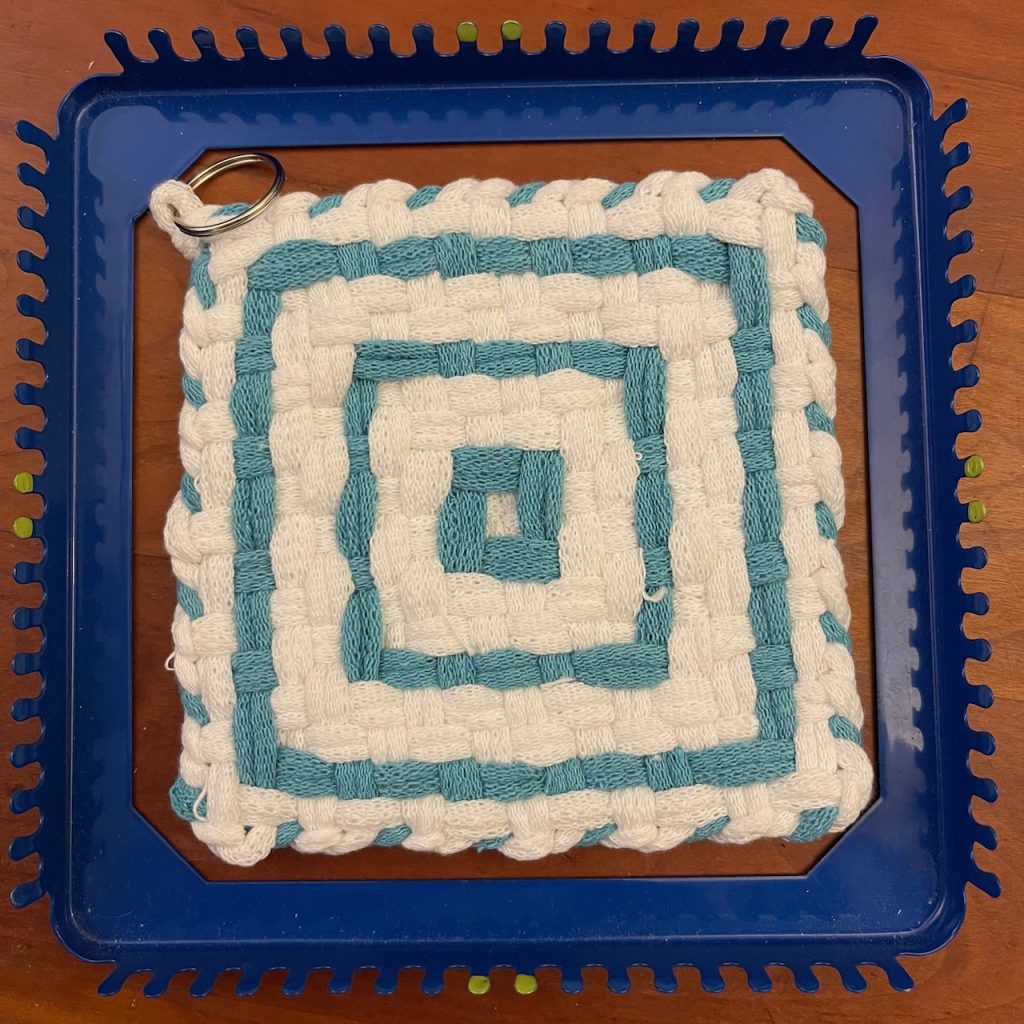
While some of our charts involve complicated weaving patterns, it’s fun to explore the interesting designs that can be produced by combining very regular weaving with a varying choice of loop colors.
Both of the designs shown below are two-two twill throughout, which is to say that you weave over two loops and then under two loops, consistently across the entire fabric, shifting the weaving over by one loop on each row. Because it’s all twill, the resulting fabric is smooth, and slightly smaller and thicker than a plain tabby (over one/under one) woven with the same loops.
They both use three colors — you can choose any three colors you would like — but one is threaded AABBCC while the other uses AABCCB. The result is a repeating pattern of organic shapes that is reminiscent of houndstooth twills, but in smaller and more varied arrangements that might bring to mind modern camouflage designs.
Piglet wove one using forest colors of green, tan, and brown, and the other with winter colors of black, white, and gray. The resulting potholders are symmetrical, with the same designs shown on the back. You can easily adapt this to 18-peg looms by only using the first eighteen rows and columns of the chart.




Such fun, exploring a new weave! This is a satin weave, adapted by Matthew Simon Ryan Cavalletto from a handweaving.net draft.
There’s always that moment, taking a new weave with floats off the loom, when you wonder if it will all fall apart, or prove a sturdy, pleasant fabric. Success! This is soft to the touch, resists bias, and drapes well in the hand for a secure grip.
I found it easy to weave, once I got going. The pattern established itself rapidly and I did not need to refer to the chart after the first several rows.
It has a lovely texture, not well captured on photos. The loops here are Harrisville navy and white. I look forward to seeing what people do with the colors!















Adventures in twill continued! Wherein we discover that the back of draft pattern “Separated Twill Crosses” is really the front! This is an astounding fabric that feels very different on each side, and looks on one side nothing like you would expect from the chart.
As I wove this one, I made several changes to the chart that will be reflected in the published version.










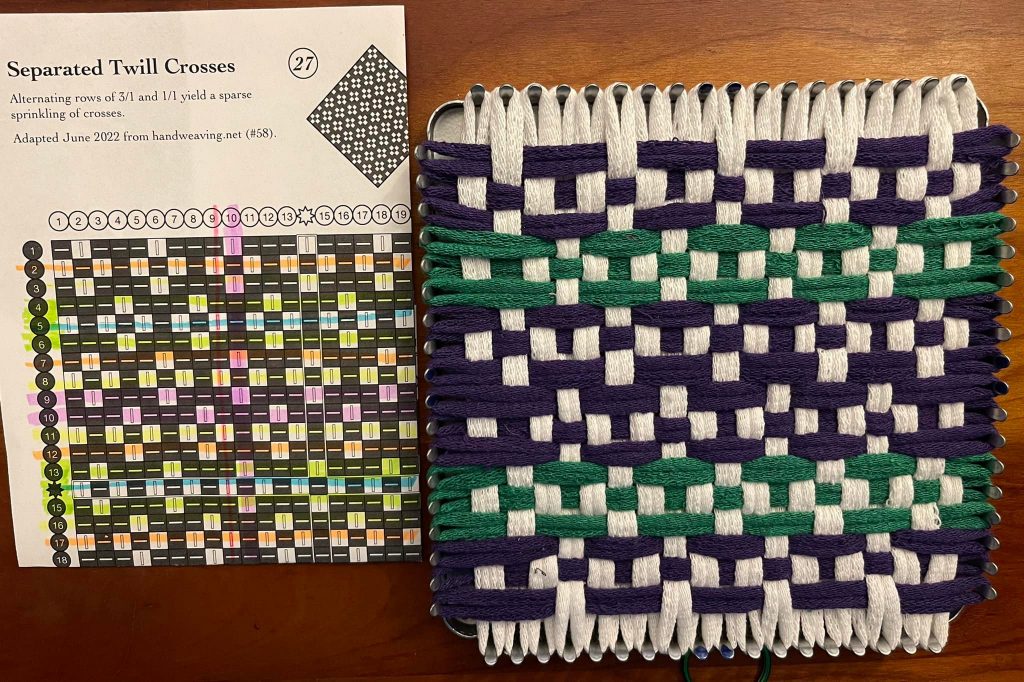







This is another of those double-thick magic weaves that looks like one thing on the loom, then draws up very differently when bound off. The result is thick, flat, and resembles a tabby (over/under) weave with a slight bias to the pattern.
The weaving pattern is very simple, 3 over / 3 under across the row, moving 2 columns to the right with each subsequent row. Moving one column to the right produces the pattern we called three-three twill, which has the same 3/3 pattern in the columns. This new pattern, moving 2 columns, we’re calling three-three shift twill, and it has a 2/1 pattern in the columns. Alternating columns are forced to overlap each other when the rows draw up across their 3-floats. Picture time!
